engine YAMAHA TMAX 2014 User Guide
[x] Cancel search | Manufacturer: YAMAHA, Model Year: 2014, Model line: TMAX, Model: YAMAHA TMAX 2014Pages: 100, PDF Size: 3.01 MB
Page 23 of 100
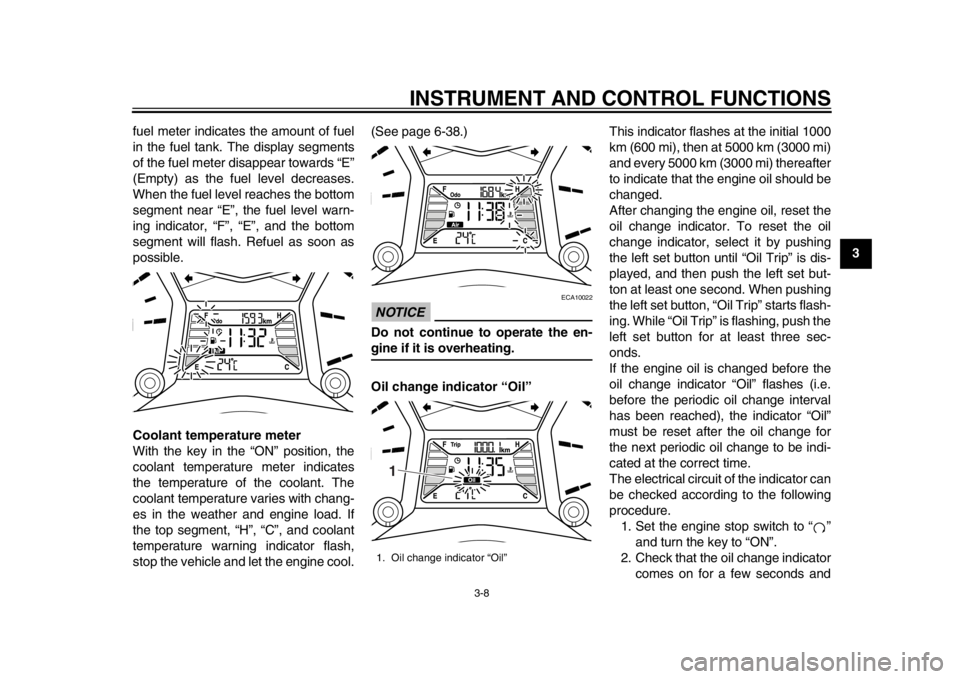
INSTRUMENT AND CONTROL FUNCTIONS
3-8
234
5
6
7
8
9
fuel meter indicates the amount of fuel
in the fuel tank. The display segments
of the fuel meter disappear towards “E”
(Empty) as the fuel level decreases.
When the fuel level reaches the bottom
segment near “E”, the fuel level warn-
ing indicator, “F”, “E”, and the bottom
segment will flash. Refuel as soon as
possible.
Coolant temperature meter
With the key in the “ON” position, the
coolant temperature meter indicates
the temperature of the coolant. The
coolant temperature varies with chang-
es in the weather and engine load. If
the top segment, “H”, “C”, and coolant
temperature warning indicator flash,
stop the vehicle and let the engine cool. (See page 6-38.)
NOTICE
ECA10022
Do not continue to operate the en-gine if it is overheating.
Oil change indicator “Oil”
This indicator flashes at the initial 1000
km (600 mi), then at 5000 km (3000 mi)
and every 5000 km (3000 mi) thereafter
to indicate that the engine oil should be
changed.
After changing the engine oil, reset the
oil change indicator. To reset the oil
change indicator, select it by pushing
the left set button until “Oil Trip” is dis-
played, and then push the left set but-
ton at least one second. When pushing
the left set button, “Oil Trip” starts flash-
ing. While “Oil Trip” is flashing, push the
left set button for at least three sec-
onds.
If the engine oil is changed before the
oil change indicator “Oil” flashes (i.e.
before the periodic oil change interval
has been reached), the indicator “Oil”
must be reset after the oil change for
the next periodic oil change to be indi-
cated at the correct time.
The electrical circuit of the indicator can
be checked according to the following
procedure.
1. Set the engine stop switch to “ ” and turn the key to “ON”.
2. Check that the oil change indicator comes on for a few seconds and1. Oil change indicator “Oil”1
59C-9-E2.book 8 ページ 2013年6月18日 火曜日 午後1時33分
Page 24 of 100
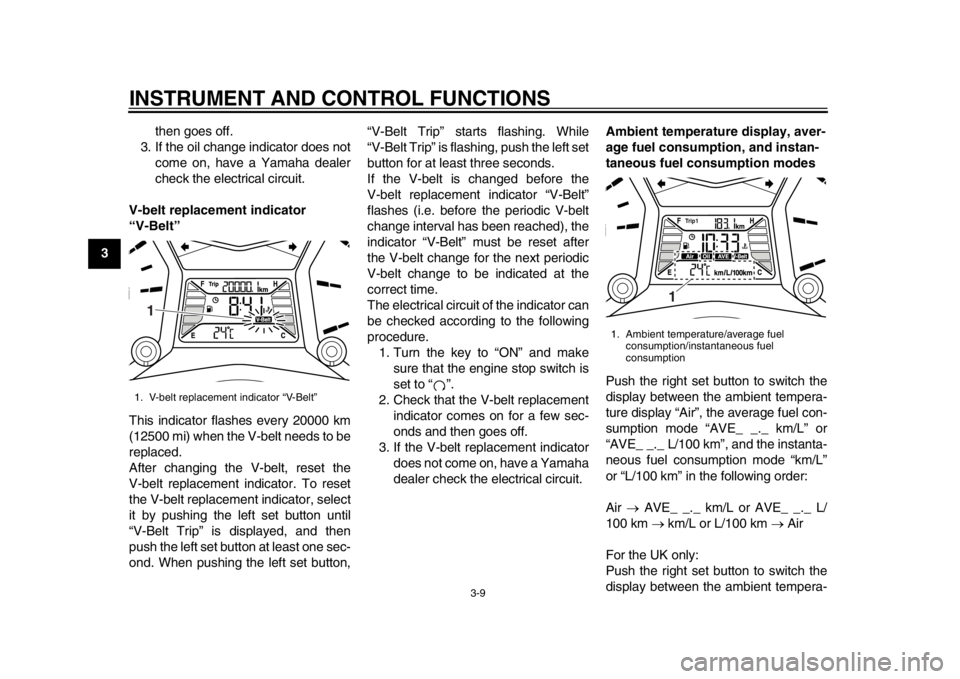
INSTRUMENT AND CONTROL FUNCTIONS
3-9
1
23
4
5
6
7
8
9then goes off.
3. If the oil change indicator does not come on, have a Yamaha dealer
check the electrical circuit.
V-belt replacement indicator
“V-Belt”
This indicator flashes every 20000 km
(12500 mi) when the V-belt needs to be
replaced.
After changing the V-belt, reset the
V-belt replacement indicator. To reset
the V-belt replacement indicator, select
it by pushing the left set button until
“V-Belt Trip” is displayed, and then
push the left set button at least one sec-
ond. When pushing the left set button, “V-Belt Trip” starts flashing. While
“V-Belt Trip” is flashing, push the left set
button for at least three seconds.
If the V-belt is changed before the
V-belt replacement indicator “V-Belt”
flashes (i.e. before the periodic V-belt
change interval has been reached), the
indicator “V-Belt” must be reset after
the V-belt change for the next periodic
V-belt change to be indicated at the
correct time.
The electrical circuit of the indicator can
be checked according to the following
procedure.
1. Turn the key to “ON” and make sure that the engine stop switch is
set to “ ”.
2. Check that the V-belt replacement indicator comes on for a few sec-
onds and then goes off.
3. If the V-belt replacement indicator does not come on, have a Yamaha
dealer check the electrical circuit. Ambient temperature display, aver-
age fuel consumption, and instan-
taneous fuel consumption modes
Push the right set button to switch the
display between the ambient tempera-
ture display “Air”, the average fuel con-
sumption mode “AVE_ _._ km/L” or
“AVE_ _._ L/100 km”, and the instanta-
neous fuel consumption mode “km/L”
or “L/100 km” in the following order:
Air
AVE_ _._ km/L or AVE_ _._ L/
100 km km/L or L/100 km Air
For the UK only:
Push the right set button to switch the
display between the ambient tempera-
1. V-belt replacement indicator “V-Belt”1
1. Ambient temperature/average fuel consumption/instantaneous fuel
consumption
1
59C-9-E2.book 9 ページ 2013年6月18日 火曜日 午後1時33分
Page 26 of 100
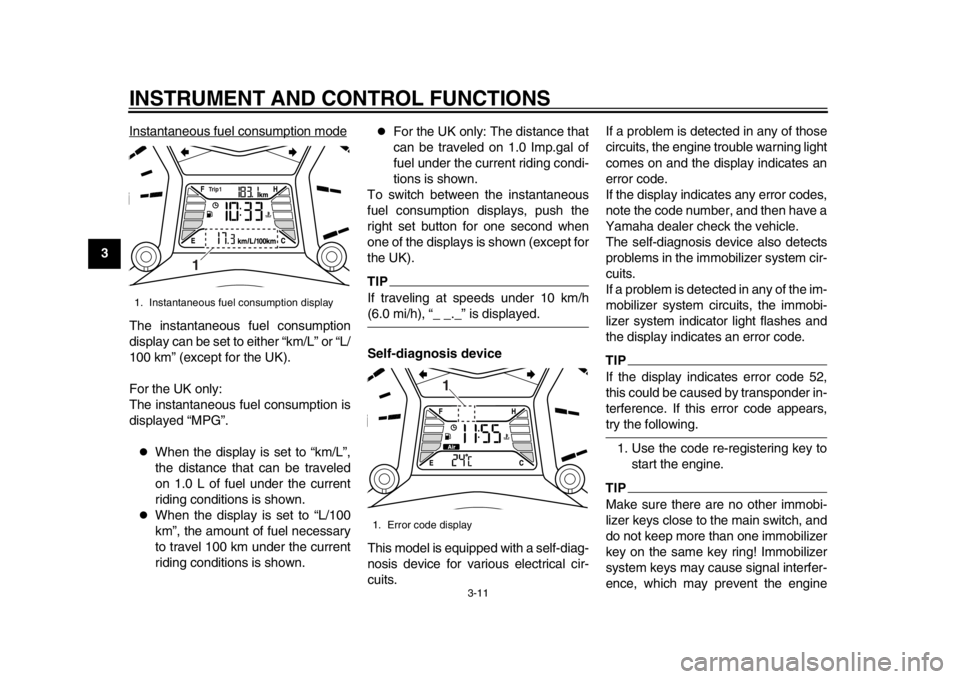
INSTRUMENT AND CONTROL FUNCTIONS
3-11
1
23
4
5
6
7
8
9Instantaneous fuel consumption mode
The instantaneous fuel consumption
display can be set to either “km/L” or “L/
100 km” (except for the UK).
For the UK only:
The instantaneous fuel consumption is
displayed “MPG”.
When the display is set to “km/L”,
the distance that can be traveled
on 1.0 L of fuel under the current
riding conditions is shown.
When the display is set to “L/100
km”, the amount of fuel necessary
to travel 100 km under the current
riding conditions is shown.
For the UK only: The distance that
can be traveled on 1.0 Imp.gal of
fuel under the current riding condi-
tions is shown.
To switch between the instantaneous
fuel consumption displays, push the
right set button for one second when
one of the displays is shown (except for
the UK).
TIPIf traveling at speeds under 10 km/h(6.0 mi/h), “_ _._” is displayed.
Self-diagnosis device
This model is equipped with a self-diag-
nosis device for various electrical cir-
cuits. If a problem is detected in any of those
circuits, the engine trouble warning light
comes on and the display indicates an
error code.
If the display indicates any error codes,
note the code number, and then have a
Yamaha dealer check the vehicle.
The self-diagnosis device also detects
problems in the immobilizer system cir-
cuits.
If a problem is detected in any of the im-
mobilizer system circuits, the immobi-
lizer system indicator light flashes and
the display indicates an error code.
TIPIf the display indicates error code 52,
this could be caused by transponder in-
terference. If this error code appears,try the following.
1. Use the code re-registering key to start the engine.TIPMake sure there are no other immobi-
lizer keys close to the main switch, and
do not keep more than one immobilizer
key on the same key ring! Immobilizer
system keys may cause signal interfer-
ence, which may prevent the engine
1. Instantaneous fuel consumption display
1
1. Error code display
1
59C-9-E2.book 11 ページ 2013年6月18日 火曜日 午後1時33分
Page 27 of 100

INSTRUMENT AND CONTROL FUNCTIONS
3-12
234
5
6
7
8
9
from starting.2. If the engine starts, turn it off and try starting the engine with the
standard keys.
3. If one or both of the standard keys do not start the engine, take the
vehicle, the code re-registering
key and both standard keys to a
Yamaha dealer and have the stan-
dard keys re-registered.NOTICE
ECA11591
If the display indicates an error
code, the vehicle should be checked
as soon as possible in order to avoidengine damage.
EAU1234F
Handlebar switchesLeft Right
EAU12361
Pass switch “PASS”
Press this switch to flash the headlight.
EAU12401
Dimmer switch “ / ”
Set this switch to “ ” for the high
beam and to “ ” for the low beam.
EAU12461
Turn signal switch “ / ”
To signal a right-hand turn, push this
switch to “ ”. To signal a left-hand
turn, push this switch to “ ”. When re-
leased, the switch returns to the center
1. Pass switch “PASS”
2. Dimmer switch “ / ”
3. Turn signal switch “ / ”
4. Horn switch “ ”
1
2
3
4
1. Engine stop switch “ / ”
2. Hazard switch “ ”
3. Start switch “ ”
1
2
3
59C-9-E2.book 12 ページ 2013年6月18日 火曜日 午後1時33分
Page 28 of 100
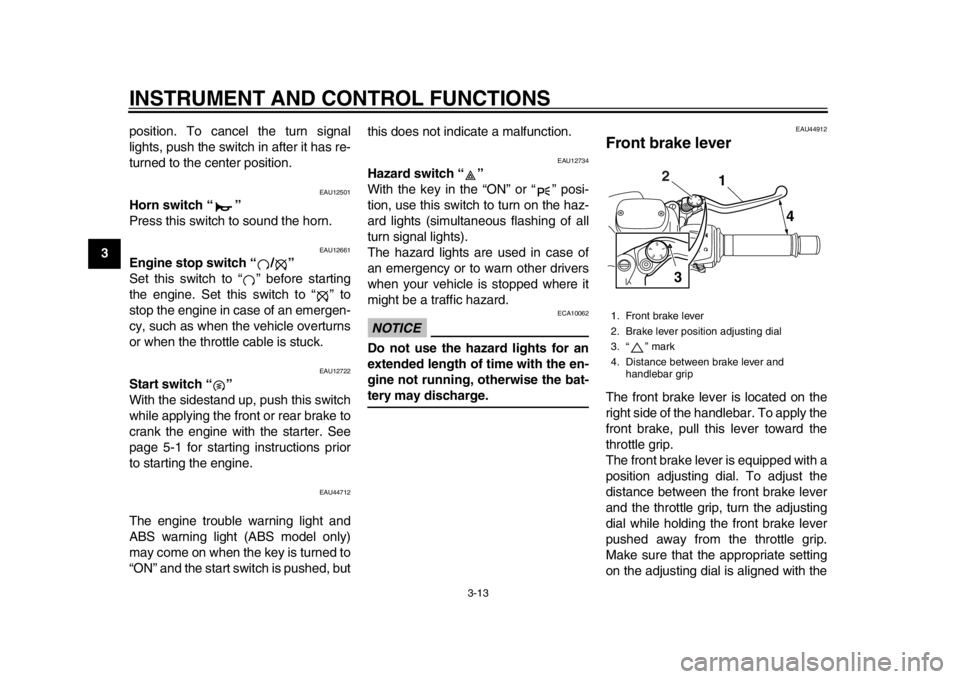
INSTRUMENT AND CONTROL FUNCTIONS
3-13
1
23
4
5
6
7
8
9position. To cancel the turn signal
lights, push the switch in after it has re-
turned to the center position.
EAU12501
Horn switch “ ”
Press this switch to sound the horn.
EAU12661
Engine stop switch “ / ”
Set this switch to “ ” before starting
the engine. Set this switch to “ ” to
stop the engine in case of an emergen-
cy, such as when the vehicle overturns
or when the throttle cable is stuck.
EAU12722
Start switch “ ”
With the sidestand up, push this switch
while applying the front or rear brake to
crank the engine with the starter. See
page 5-1 for starting instructions prior
to starting the engine.
EAU44712
The engine trouble warning light and
ABS warning light (ABS model only)
may come on when the key is turned to
“ON” and the start switch is pushed, but this does not indicate a malfunction.
EAU12734
Hazard switch “ ”
With the key in the “ON” or “ ” posi-
tion, use this switch to turn on the haz-
ard lights (simultaneous flashing of all
turn signal lights).
The hazard lights are used in case of
an emergency or to warn other drivers
when your vehicle is stopped where it
might be a traffic hazard.NOTICE
ECA10062
Do not use the hazard lights for an
extended length of time with the en-
gine not running, otherwise the bat-tery may discharge.
EAU44912
Front brake leverThe front brake lever is located on the
right side of the handlebar. To apply the
front brake, pull this lever toward the
throttle grip.
The front brake lever is equipped with a
position adjusting dial. To adjust the
distance between the front brake lever
and the throttle grip, turn the adjusting
dial while holding the front brake lever
pushed away from the throttle grip.
Make sure that the appropriate setting
on the adjusting dial is aligned with the1. Front brake lever
2. Brake lever position adjusting dial
3. “ ” mark
4. Distance between brake lever and
handlebar grip
1
4
2
3
59C-9-E2.book 13 ページ 2013年6月18日 火曜日 午後1時33分
Page 32 of 100
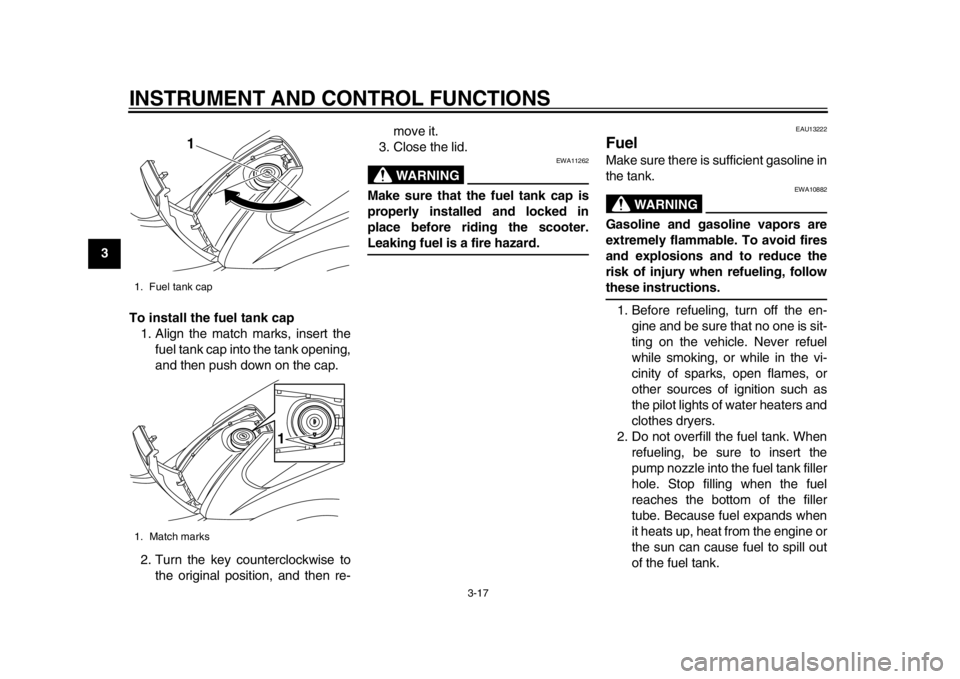
INSTRUMENT AND CONTROL FUNCTIONS
3-17
1
23
4
5
6
7
8
9To install the fuel tank cap
1. Align the match marks, insert the fuel tank cap into the tank opening,
and then push down on the cap.
2. Turn the key counterclockwise to the original position, and then re- move it.
3. Close the lid.
WARNING
EWA11262
Make sure that the fuel tank cap is
properly installed and locked in
place before riding the scooter.Leaking fuel is a fire hazard.
EAU13222
FuelMake sure there is sufficient gasoline in
the tank.
WARNING
EWA10882
Gasoline and gasoline vapors are
extremely flammable. To avoid fires
and explosions and to reduce the
risk of injury when refueling, followthese instructions.
1. Before refueling, turn off the en- gine and be sure that no one is sit-
ting on the vehicle. Never refuel
while smoking, or while in the vi-
cinity of sparks, open flames, or
other sources of ignition such as
the pilot lights of water heaters and
clothes dryers.
2. Do not overfill the fuel tank. When refueling, be sure to insert the
pump nozzle into the fuel tank filler
hole. Stop filling when the fuel
reaches the bottom of the filler
tube. Because fuel expands when
it heats up, heat from the engine or
the sun can cause fuel to spill out
of the fuel tank.
1. Fuel tank cap
1. Match marks
1
1
59C-9-E2.book 17 ページ 2013年6月18日 火曜日 午後1時33分
Page 33 of 100
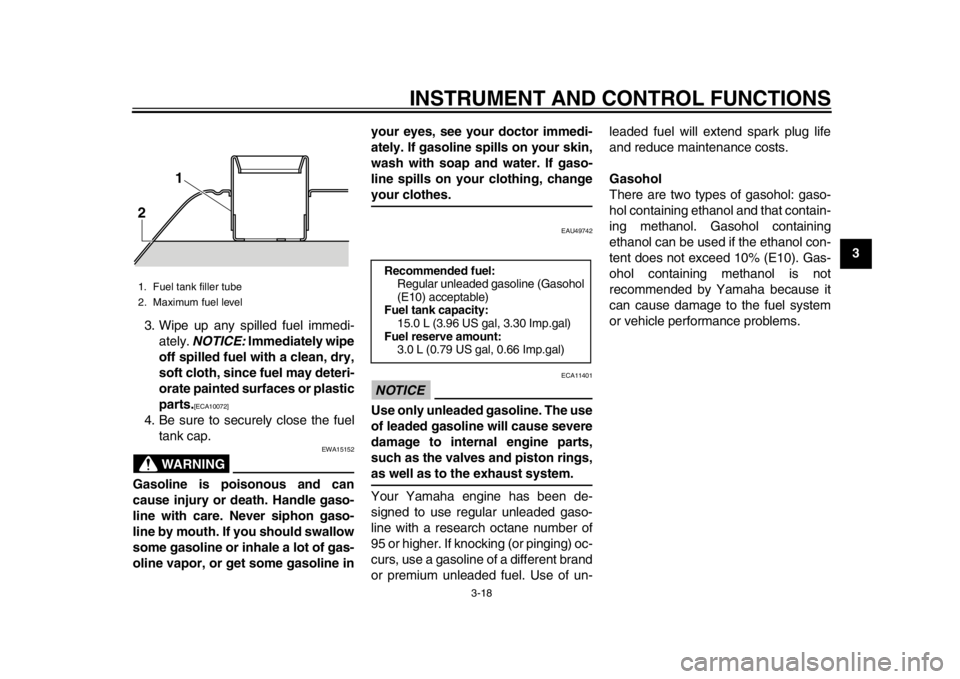
INSTRUMENT AND CONTROL FUNCTIONS
3-18
234
5
6
7
8
9
3. Wipe up any spilled fuel immedi-
ately. NOTICE: Immediately wipe
off spilled fuel with a clean, dry,
soft cloth, since fuel may deteri-
orate painted surfaces or plastic
parts.
[ECA10072]
4. Be sure to securely close the fuel tank cap.
WARNING
EWA15152
Gasoline is poisonous and can
cause injury or death. Handle gaso-
line with care. Never siphon gaso-
line by mouth. If you should swallow
some gasoline or inhale a lot of gas-
oline vapor, or get some gasoline in your eyes, see your doctor immedi-
ately. If gasoline spills on your skin,
wash with soap and water. If gaso-
line spills on your clothing, change
your clothes.
EAU49742
NOTICE
ECA11401
Use only unleaded gasoline. The use
of leaded gasoline will cause severe
damage to internal engine parts,
such as the valves and piston rings,as well as to the exhaust system.
Your Yamaha engine has been de-
signed to use regular unleaded gaso-
line with a research octane number of
95 or higher. If knocking (or pinging) oc-
curs, use a gasoline of a different brand
or premium unleaded fuel. Use of un-leaded fuel will extend spark plug life
and reduce maintenance costs.
Gasohol
There are two types of gasohol: gaso-
hol containing ethanol and that contain-
ing methanol. Gasohol containing
ethanol can be used if the ethanol con-
tent does not exceed 10% (E10). Gas-
ohol containing methanol is not
recommended by Yamaha because it
can cause damage to the fuel system
or vehicle performance problems.
1. Fuel tank filler tube
2. Maximum fuel level2
1
Recommended fuel:
Regular unleaded gasoline (Gasohol
(E10) acceptable)
Fuel tank capacity: 15.0 L (3.96 US gal, 3.30 Imp.gal)
Fuel reserve amount:
3.0 L (0.79 US gal, 0.66 Imp.gal)
59C-9-E2.book 18 ページ 2013年6月18日 火曜日 午後1時33分
Page 34 of 100
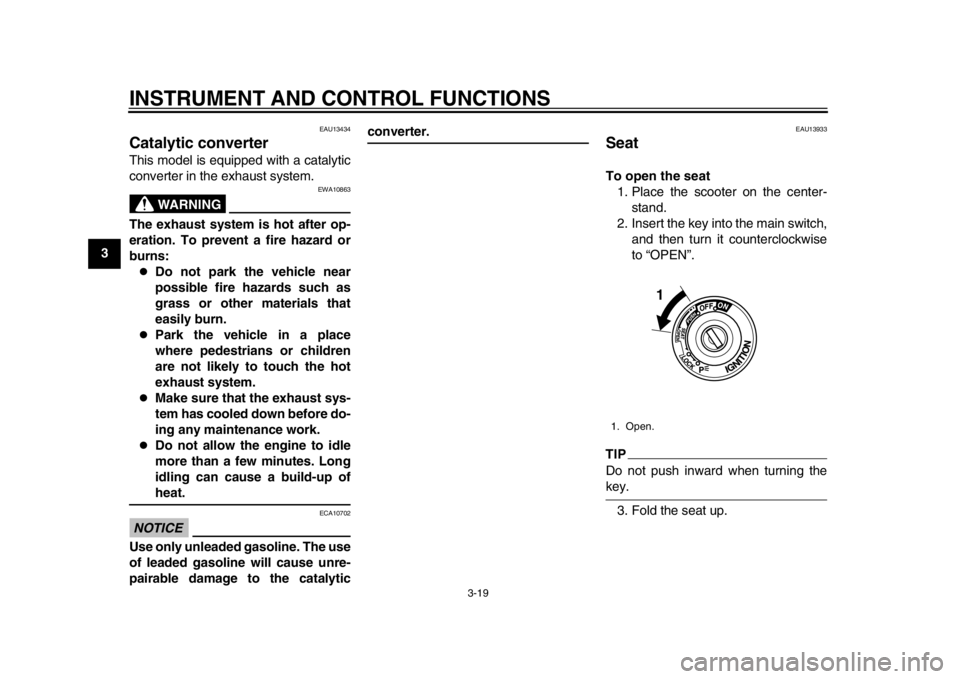
INSTRUMENT AND CONTROL FUNCTIONS
3-19
1
23
4
5
6
7
8
9
EAU13434
Catalytic converterThis model is equipped with a catalytic
converter in the exhaust system.
WARNING
EWA10863
The exhaust system is hot after op-
eration. To prevent a fire hazard or
burns:
Do not park the vehicle near
possible fire hazards such as
grass or other materials that
easily burn.
Park the vehicle in a place
where pedestrians or children
are not likely to touch the hot
exhaust system.
Make sure that the exhaust sys-
tem has cooled down before do-
ing any maintenance work.
Do not allow the engine to idle
more than a few minutes. Long
idling can cause a build-up ofheat.
NOTICE
ECA10702
Use only unleaded gasoline. The use
of leaded gasoline will cause unre-
pairable damage to the catalytic
converter.
EAU13933
SeatTo open the seat1. Place the scooter on the center- stand.
2. Insert the key into the main switch, and then turn it counterclockwise
to “OPEN”.TIPDo not push inward when turning thekey.
3. Fold the seat up.1. Open.
1
59C-9-E2.book 19 ページ 2013年6月18日 火曜日 午後1時33分
Page 37 of 100
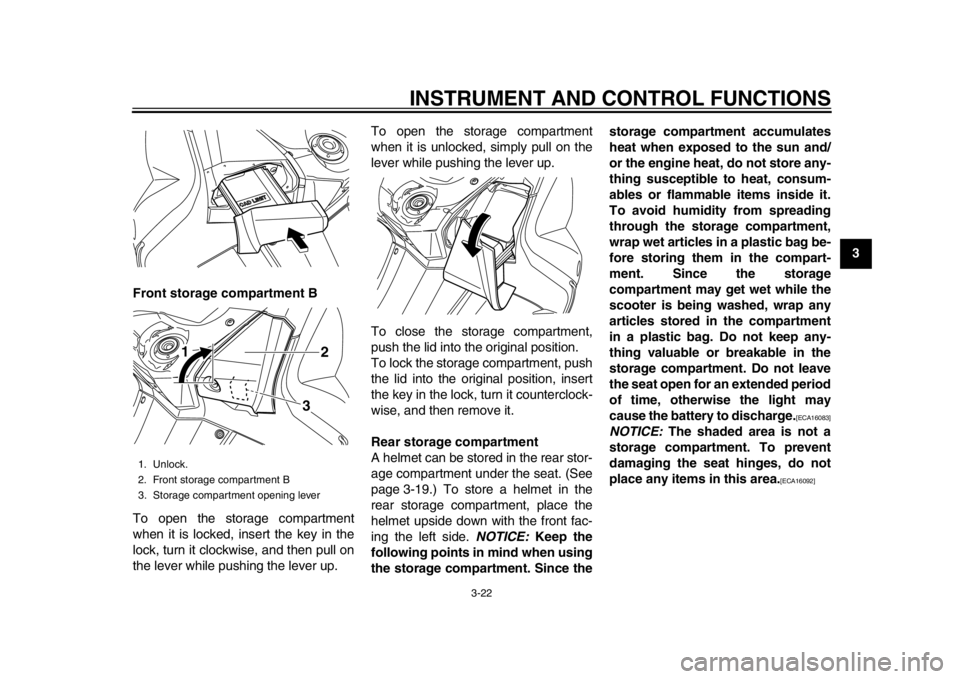
INSTRUMENT AND CONTROL FUNCTIONS
3-22
234
5
6
7
8
9
Front storage compartment B
To open the storage compartment
when it is locked, insert the key in the
lock, turn it clockwise, and then pull on
the lever while pushing the lever up. To open the storage compartment
when it is unlocked,
simply pull on the
lever while pushing the lever up.
To close the storage compartment,
push the lid into the original position.
To lock the storage compartment, push
the lid into the original position, insert
the key in the lock, turn it counterclock-
wise, and then remove it.
Rear storage compartment
A helmet can be stored in the rear stor-
age compartment under the seat. (See
page 3-19.) To store a helmet in the
rear storage compartment, place the
helmet upside down with the front fac-
ing the left side. NOTICE: Keep the
following points in mind when using
the storage compartment. Since the storage compartment accumulates
heat when exposed to the sun and/
or the engine heat, do not store any-
thing susceptible to heat, consum-
ables or flammable items inside it.
To avoid humidity from spreading
through the storage compartment,
wrap wet articles in a plastic bag be-
fore storing them in the compart-
ment. Since the storage
compartment may get wet while the
scooter is being washed, wrap any
articles stored in the compartment
in a plastic bag. Do not keep any-
thing valuable or breakable in the
storage compartment. Do not leave
the seat open for an extended period
of time, otherwise the light may
cause the battery to discharge.
[ECA16083]
NOTICE:
The shaded area is not a
storage compartment. To prevent
damaging the seat hinges, do not
place any items in this area.
[ECA16092]
1. Unlock.
2. Front storage compartment B
3. Storage compartment opening lever
1 2
3
59C-9-E2.book 22 ページ 2013年6月18日 火曜日 午後1時33分
Page 41 of 100

INSTRUMENT AND CONTROL FUNCTIONS
3-26
234
5
6
7
8
9
EAU15306
SidestandThe sidestand is located on the left side
of the frame. Raise the sidestand or
lower it with your foot while holding the
vehicle upright.TIPThe built-in sidestand switch is part of
the ignition circuit cut-off system, which
cuts the ignition in certain situations.
(See the following section for an expla-
nation of the ignition circuit cut-off sys-tem.)
WARNING
EWA10242
The vehicle must not be ridden with
the sidestand down, or if the sides-
tand cannot be properly moved up
(or does not stay up), otherwise the
sidestand could contact the ground
and distract the operator, resulting
in a possible loss of control.
Yamaha’s ignition circuit cut-off
system has been designed to assist
the operator in fulfilling the respon-
sibility of raising the sidestand be-
fore starting off. Therefore, check
this system regularly and have aYamaha dealer repair it if it does not
function properly.
EAU45053
Ignition circuit cut-off systemThe ignition circuit cut-off system (com-
prising the sidestand switch and brake
light switches) has the following func-
tions.
It prevents starting when the side-
stand is up, but neither brake is ap-
plied.
It prevents starting when either
brake is applied, but the sidestand
is still down.
It cuts the running engine when the
sidestand is moved down.
Periodically check the operation of the
ignition circuit cut-off system according
to the following procedure.
59C-9-E2.book 26 ページ 2013年6月18日 火曜日 午後1時33分